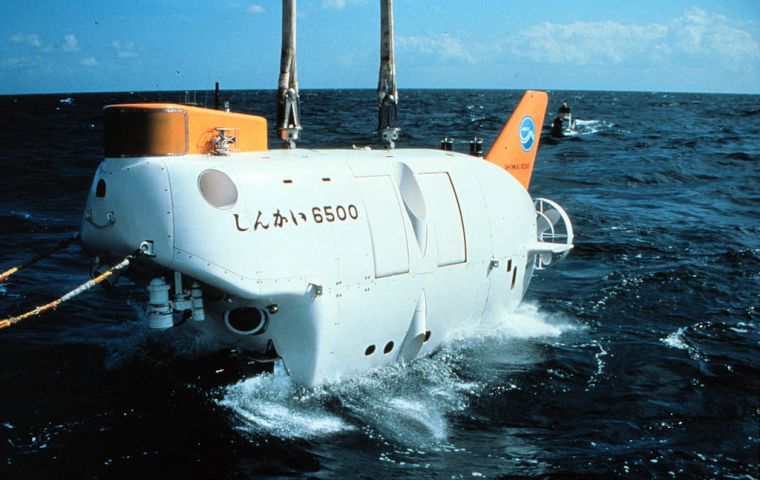MercoPress. South Atlantic News Agency
“Possible submerged continent” found in the Atlantic off the coast of Brazil
 The Japanese Shinkai 6500 manned submersible operating in the Atlantic Ocean bed
The Japanese Shinkai 6500 manned submersible operating in the Atlantic Ocean bed A large mass of granite has been found on the seabed off the coast of Rio de Janeiro, suggesting that a continent may have existed in the Atlantic Ocean, a Japanese agency and the Brazilian government announced this week.
A Brazilian official said that the discovery of the granite, which is formed only on dry land, is strong evidence that a continent existed in the area where the legendary island of Atlantis, mentioned by the ancient Greek philosopher Plato in his dialogues, was supposed to be located.
According to the legend, the island, host to a highly developed civilization, sunk into the sea in a flood around 12,000 years ago. No traces have so far been found.
The discovery was made using a Shinkai 6500 manned submersible belonging to the Japan Agency for Marine-Earth Science and Technology, JAMEST. The seabed where the granite mass was found is estimated to have sunk into the sea several tens of million years ago. No man-made structures have been found.
It is the first time research using a manned submersible has been conducted in the South Atlantic Ocean. In late April, the agency used it to explore the Rio Grande Rise, a seabed more than 1,000 kilometers southeast of Rio de Janeiro.
At a depth of 910 meters, it found a rock cliff around 10 meters in height and breadth. The agency concluded that it was granite after analyzing video data. Also found in the sea around it was a large volume of quartz sand, which is also not formed in the sea. The bedrock is believed to be mainly basalt rock.
The rise itself stretches around 1,000 kilometers at the widest point and is considered part of the continent left behind when South America and Africa were split over 100 million years ago.
JAMEST said it assumes it was above the sea until around 50 million years ago but submerged over a period of around several million years, given fossils found in the seabed around the area and other data.
According to the agency, the Rio Grande Rise is the only plausible area that could have possibly formerly been dry land.
Shinichi Kawakami, a professor at Gifu University, said that “the granite could have been a part of a big continent before it separated into Africa and South America. The next step now is to compare the granite found in Brazil with the one in these two continents”.




Top Comments
Disclaimer & comment rules-

-

-

Read all commentsDon't tell Argentina. They'll want to claim it.
May 08th, 2013 - 09:20 am 0You beat me to it :-)
May 08th, 2013 - 09:29 am 0No doubt the Japanese found the RG flag flying at the top of this granite edifice, buggers sneak in everywhere and put them up, then sneak out again.
May 08th, 2013 - 09:52 am 0Commenting for this story is now closed.
If you have a Facebook account, become a fan and comment on our Facebook Page!